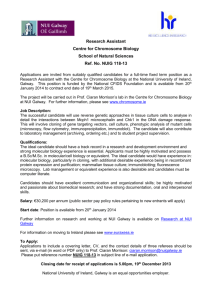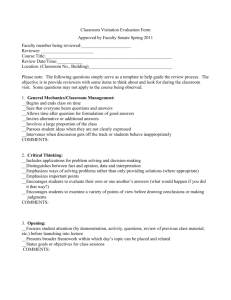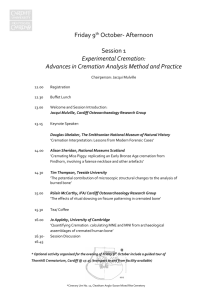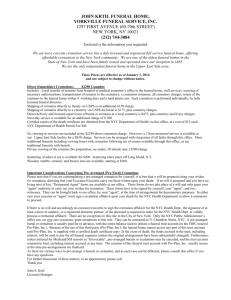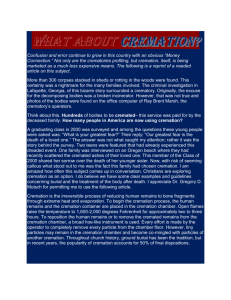PAST TIMES CHANGING FORTUNES
advertisement
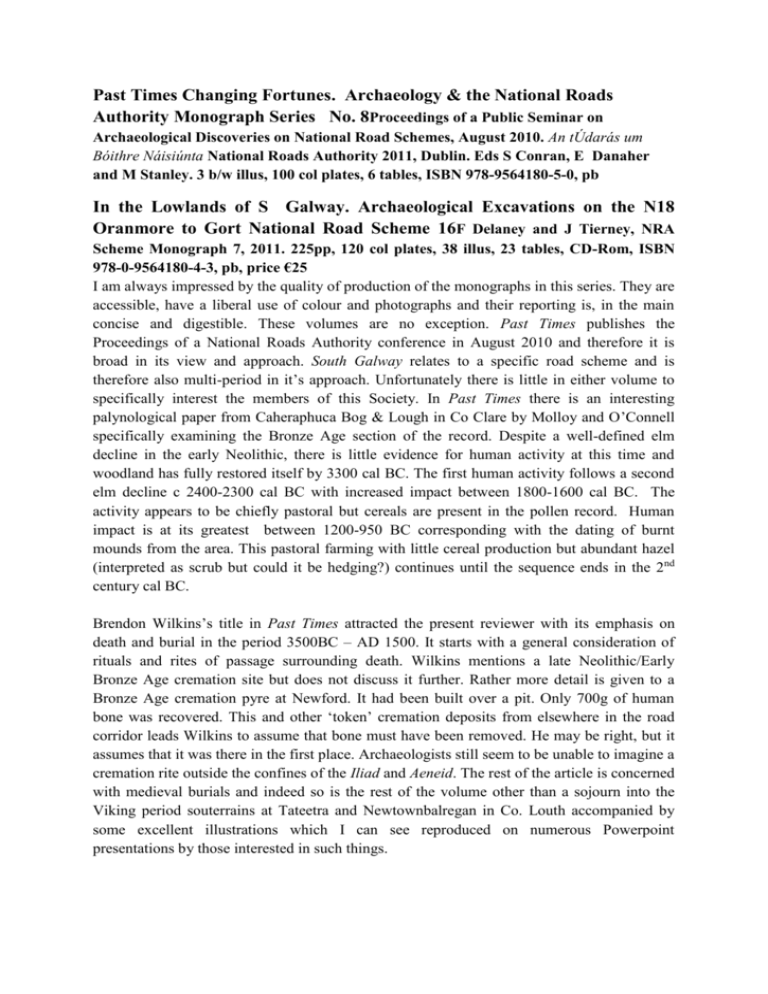
Past Times Changing Fortunes. Archaeology & the National Roads Authority Monograph Series No. 8Proceedings of a Public Seminar on Archaeological Discoveries on National Road Schemes, August 2010. An tÚdarás um Bóithre Náisiúnta National Roads Authority 2011, Dublin. Eds S Conran, E Danaher and M Stanley. 3 b/w illus, 100 col plates, 6 tables, ISBN 978-9564180-5-0, pb In the Lowlands of S Galway. Archaeological Excavations on the N18 Oranmore to Gort National Road Scheme 16F Delaney and J Tierney, NRA Scheme Monograph 7, 2011. 225pp, 120 col plates, 38 illus, 23 tables, CD-Rom, ISBN 978-0-9564180-4-3, pb, price €25 I am always impressed by the quality of production of the monographs in this series. They are accessible, have a liberal use of colour and photographs and their reporting is, in the main concise and digestible. These volumes are no exception. Past Times publishes the Proceedings of a National Roads Authority conference in August 2010 and therefore it is broad in its view and approach. South Galway relates to a specific road scheme and is therefore also multi-period in it’s approach. Unfortunately there is little in either volume to specifically interest the members of this Society. In Past Times there is an interesting palynological paper from Caheraphuca Bog & Lough in Co Clare by Molloy and O’Connell specifically examining the Bronze Age section of the record. Despite a well-defined elm decline in the early Neolithic, there is little evidence for human activity at this time and woodland has fully restored itself by 3300 cal BC. The first human activity follows a second elm decline c 2400-2300 cal BC with increased impact between 1800-1600 cal BC. The activity appears to be chiefly pastoral but cereals are present in the pollen record. Human impact is at its greatest between 1200-950 BC corresponding with the dating of burnt mounds from the area. This pastoral farming with little cereal production but abundant hazel (interpreted as scrub but could it be hedging?) continues until the sequence ends in the 2nd century cal BC. Brendon Wilkins’s title in Past Times attracted the present reviewer with its emphasis on death and burial in the period 3500BC – AD 1500. It starts with a general consideration of rituals and rites of passage surrounding death. Wilkins mentions a late Neolithic/Early Bronze Age cremation site but does not discuss it further. Rather more detail is given to a Bronze Age cremation pyre at Newford. It had been built over a pit. Only 700g of human bone was recovered. This and other ‘token’ cremation deposits from elsewhere in the road corridor leads Wilkins to assume that bone must have been removed. He may be right, but it assumes that it was there in the first place. Archaeologists still seem to be unable to imagine a cremation rite outside the confines of the Iliad and Aeneid. The rest of the article is concerned with medieval burials and indeed so is the rest of the volume other than a sojourn into the Viking period souterrains at Tateetra and Newtownbalregan in Co. Louth accompanied by some excellent illustrations which I can see reproduced on numerous Powerpoint presentations by those interested in such things. The Prehistoric content of South Galway consists almost totally of some dozen burnt mounds and the iron-working site at Caherweelder 7. Indeed, in the other volumes in the series that I have seen, hardly a volume is without its Fulachta Fiadh which creates a certain déjà vu. So too do the 20 or so radiocarbon dates which span the Bronze Age. There is an overview chapter looking at the place of these sites in the landscape (there are a lot of them and they’re usually close to water) and then a site by site summary with full data on an accompanying CD. The hearth/furnace at Caherweelder dates to the BC/AD transition. The rest of the volume is devoted to medieval and later sites. Again the standard of reporting is excellent with superb plans and photographs, the report summaries written in an accessible style with full data on CD. As a prehistorian, this reviewer found Past Times disappointing, not so much because of the lack of prehistory in its pages (a glance at the table of contents clearly illustrated this) but at the lack of prehistory in the articles that purported to deal with the period. South Galway does what it purports to do but there are only so many burnt mounds that the present reviewer can deal with. This rather sarcastic view is not intended to be rude, these are excellent volumes, however it highlights one of the problems in reporting on these large road schemes. It is logical that they should encounter multi-period archaeology and it is proper that all periods be reported. That is certainly done. However it means that few of these volumes will be of complete interest to everyone. Would it be better to publish road scheme archaeology by period or by scheme? It is a difficult conundrum. The first attracts interest group attention, the latter keeps schemes together in their entirety and doubtless simplifies post-excavation funding. The authors and editors are forced to adopt a utilitarian approach to reporting and thus unavoidably fail to please all the people all of the time. Perhaps with the increased use of digital publication, already well exploited by the Road Scheme publications, there may be scope to produce period round-ups. Alex Gibson University of Bradford December 2012 “The views expressed in this review are not necessarily those of the Society or the Reviews Editor”






